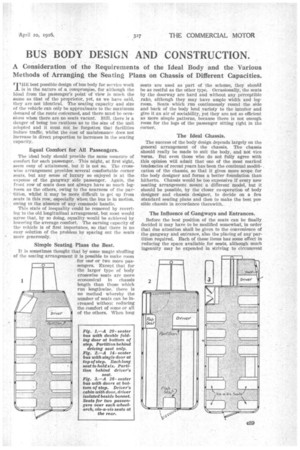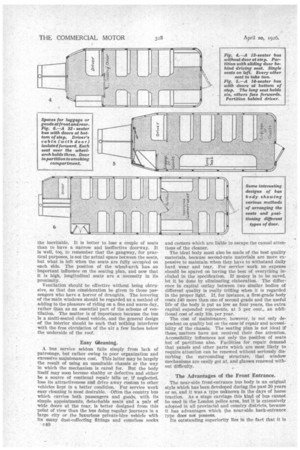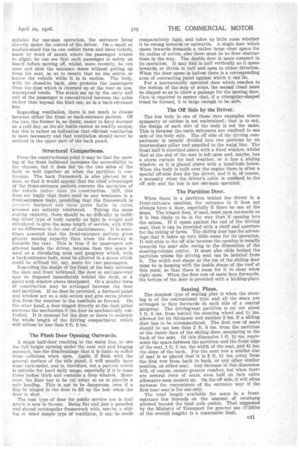BUS BODY DESIGN AND CONSTRUCTION.
Page 23

Page 24

Page 25

If you've noticed an error in this article please click here to report it so we can fix it.
A Consideration of the Requirements of the Ideal Body and the Various Methods of Arranging the Seating Plans on Chassis of Different Capacities.
• THE best possible design of bus body for service work 1 is in the nature of a compromise, for although the ideal from the passenger's point of view is much the same as that of. the proprietor, yet, as we have said, • they are not identical. The seating capacity and size of the vehicle can only be approximate to the maximum demand of the route concerned, and there must be occasions when there are no seats vacant. Still, there is a danger of being too cautious as to the size of the unit adopted and it must not be forgotten that facilities induce traffic, whilst the cost of maintenance does not increase in direct proportion to increases in the seating capacity.
Equal Comfort for All Passengers.
The ideal body should provide the same measure of comfort for each passenger. This might, at first sight, seem easy of attainment, but it is not so. The crosswise arrangement provides several comfortable corner seats, but any sense of luxury •so enjoyed is at the expense of the gangway side passenger. Again, the front row of seats does not always have so much legroom as the others, owing to the nearness of the partition, whilst it may be more difficult to get up from seats in this row, especially when the bus is in motion. owing to. the absence of any commode handle; • This state of inequality could be removed by reverting to the old longitudinal arrangement, but most would agree that, by so doing, equality would be achieved by lowering the average comfort. The earning capacity of the vehicle is of first importance, so that there is no easy solution of the problem by spacing out the seats more generously.
Simple Seating Plans the Best.
It is sometimes thought that by some magic shuffling of the seating arrangement it is possible to make room for one or two more passengers. Except that for the larger type ' of body crosswise seats are more economical in chassis length -than those which run lengthwise, there is no method whereby the number of seats can be increased without reducing the comfort of some or all of the others. When long
seats are used as part of the scheme, they should be as restful as the other type. Occasionally, the seats by the doorway are hard and without any perceptible rake, although they may have ample width and legroom. Seats which run continuously round the side and back of the body lend variety to the interior and give it an air of sociability, yet they are not so efficient as more simple patterns, because there is not enough room for the legs of the passenger sitting right in the corner.
The Ideal Chassis.
The success of the body design depends largely on the general arrangement of the chassis. The chassis should really be made to suit the body, and not vice versa. But even those who do not fully agree with this opinion will admit that one of the most marked tendencies of recent years has been the continual modification of the chassis, so that it gives more scope for the body designer and forms a better foundation than hitherto. Chassis would be too expensive if every new seating arrangement meant a different model, but it should be possible, by the closer co-operation of body designer and chassis designer, to decide on a few standard seating plans and then to make the best possible chassis in accordance therewith.
The Influence of Gangways and Entrances.
Before the best position of the seats can be finally decided it may have to be modified somewhat, in order that due attention shall be given to the convenience of the gangway and entrance, also the placing of any partitian required. Each of these items has same effect in reducing the space available for seats, although much ingenuity may be expended in striving to circumvent
the inevitable. It is better to lose a couple of seats than to have a narrow and ineffective doorway. It is well, tat?, to remember that the gangway, for practical purposes, is not the actual space between the seats, but what is left when the seats are fully occupied on each side. The position of the wheel-arch has. an Important influence on the seating plan, and now that it is high, longitudinal seats are a necessity in its proximity.
Ventilation should be effective without being obtrusive, so that due consideration be given to those passengers who have a horror of draughts. The lowering of the main windows should be regarded as a method of adding to the pleasure of riding on a fine and warm day, rather than as an essential part of the scheme of ventilation. The matter is of importance because the bus is a multi-seated closed vehicle, and the general design of the interior should be such that nothing interferes with the free circulation of the air a few inches below the underside of the roof.
Easy Gleaning.
A bus service seldom fails simply from lack of patronage, but rather owing to poor organization and excessive majntenance cost. This latter may be largely the result of using an unsuitable chassis or the way in which the mechanism is cared for. But the body itself may soon become shabby or defective and either be a source of continual repair bills or, if neglected, lose its attractiveness and drive away custom to other vehicles kept in a better condition. For service work easy cleaning is most desirable. Often the country bus which carries both passengers and goods, with its simple appointments, detachable seats and a pair of wide doors at the rear, is better designed from this point of view than the bus doing regular journeys in a large city or the luxurious private-hire vehicle with its many dust-collecting fittings and countless nooks ' c40
and corners which are liable to escape the casual attentions of the cleaner.
The ideal body must also be made of the best quality materials, because second-rate materials are more expansive to maintain when they have to withstand daily hard wear and tear. For service work no expense should be spared on having the best of everything included in the specification. If money is to be saved, let it he done by eliminating elaboration. The difference in capital outlay between two similar bodies of different quality is really trifling when it is regarded in the proper light. If, for instance, a first-grade body costs i40 more than one of second grade and the useful rife of the body is put as low as four years, the extra capital expended represents, at 5 per cent., an additional cost of only 10s. per year.
The cost of maintenance, however, is not only dependent on quality but on the ease of repair and accessibility of the chassis. The seating plan is dot ideal if these, matters have not received their due attention. Accessibility influences not only the position of seats but of partitions also. Facilities for repair demand that panels and other parts which are moat likely to require attention can be renewed without seriously disturbing the surrounding structure, that window mechanisms are easily got at, and glasses renewed without difficulty.
The Advantages of the Front Entrance.
The near-side front-entrance bus body is an original style which has been developed during the past 20 years or so, and it was a type unknowa in the days of horse traction. As a stage carriage this kind of bus cannot be used in the London police area, but it is extensively adopted in all provincial and country districts, because it has advantages which the near-side back-entrance type does not possess.
Its outstanding superiority lies in the fact that it is
Regarding ventilation, there is not much to choose between either the front or back-entrance pattern. Of the two, the former is, no doubt, easier to keep warmer on a cold day, as the air inside cannot so readily escape, but this is rather an indication that efficient ventilation is more necessary and that ventilation should never be omitted in the upper part of the back panel.
Structural Comparisons.
From the constructional point it may be that the opening of the frent bulkhead increases the accessibility to the chassis, but it does not tie the two sides of the body so well together as when the partition is continuous. The back framework is also pierced by a door, so that it would appear that the chief advantages of the front-entrance pattern concern the operation of the vehicle rather than its construction. Still, this does not imply that there need be any. weakness in a front-entrance body, providing that the framework is proaarly • designed: and those parts liable to extra stresses are suitably reinfcirced. Taking the same seating capacity, there should be no difficulty in building either type of body equally as light in weight and calculated to give the same length of service, with little or no difference in the cost of maintenance. It is sometimes asserted that the front-entrance pattern gives greater seating capacity than when the doorway is towards the rear. This is true if no passengers are allowed beside the driver, because then this space is used as a circulating area and gangway which, with a back-entrance body, must be allotted in a space which could be Utilized for, say, seats for two passengers.
Regarding the design of the front of the body between the dash and front bulkhead, the door or entrance-way may be disposed immediately behind the dash, or a panel with window above interposed. Or a similar form of construction may be arranged between the door and partition. If no door be provided, a forward panel and window act as a side screen and give extra protection from the weather in the vestibule so formed. On the other hand, a door hinged directly at the dash pillar shortens the mechanism if the door be mechanically controlled. It is unusual for the door or doors to embrace the whole length of the driving compartment, which will seldom be less than 3 ft. 8 ins.
The Flush Door Opening Outwards.
A single half-door reaching to the waist line, or one the full height opening under the cant rail and hinging outward, has the disadvantage that it is liable to suffer from collisions when open. Again, if flush with the general surface of the side panel, it will usually have some turn-under, and is, therefore, not a pattern which is suitable for hard daily usage, especially if it is some three inches thick and contains a drop window. Moreover, the floor has to be cut away so as to provide a safe landing. This is apt to be dangerous, even if a flap be hinged to the door to fill up the hole when the door is shut.
The best type of door for public service use is that which is now in favour. Being flat and just a panelled and glazed rectangular framework with, maybe, a sliding or other simple type of ventilator, it can be made comparatively light, and takes up little room whether it be swung inwards or outwards. A single door which opens inwards demands a rather large clear space for its radius of action, also there must be no floor obstructions lathe way. The double door is more compact in its operation. It may fold in half vertically as it opens inwards, or divide in half and open in either direction. When the door opens in halves there is a corresponding area of contracting panel against which it can lie.
For a mechanically operated door which reaches to the bottom of the step or steps, the second tread must be shaped so as to allow a passage for the moving door. Care is required to ensure that, if a triangular-shaped tread be formed, it is large enough to be safe.
The Off Side by the Driver. suitable for one-man operation, the entrance lieing -directly under the control of the driver. on a small or medium-sized bus he can collect fares and issue tickets, know by word of mouth where the passenger wishes to alight, he can see that each passenger is safely on board before moving off, whilst, more recently; he can Open and shut the entrance doors without getting up from his seat, so as to ensure that no one enters or leaves the vehicle while it is in motion. The body, with its closed-in back, also protects the passengers from the dust which is churned up at the rear on nonwaterproof roads. The strain set up by the entry and exit of the passenger is concentrated between the axles rather than beyond the hind one, as in a back-entrance bus.
































